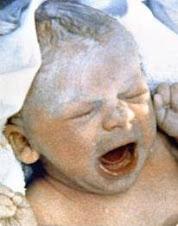IVF means in vitro fertilisation which means fertilisation 'in glass' or outside the body.
IVF is necessary where other methods of treatment of infertility have failed. Whatever the cause of the problem, it is usually because the the sperm and the eggs are not uniting to form an embryo. if there is a sperm problem and the treatment of the cause of the sperm problem has failed, then a couple may require assisted conception. If there is an egg problem and ovulation cannot be induced, the woman may require assisted conception. If she has a tube problem which cannot be treated by simple methods, she will need assisted conception.
THE PROCESS OF IVF: AN IVF CYCLE
STEP 1: OVARIAN STIMULATION AND MONITORING
In a normal cycle, a single egg is produced in the ovary every month. To maximize the chances of successful fertilisation with each IVF attempt, the woman is given drugs (menogon, puregon, pergonal, humegon, metrodin, etc) to produce a lot of eggs. The growth and development of the eggs is closely monitored by repeated ultrasound and or blood tests. Based on information obtained from these tests, it is determined when ovulation will take place. Release of eggs from the ovary is then achieved by administering an injection called HCG. The woman will then be ready for egg collection. The eggs are are collected using ultrasound to guide a needle into the ovaries.
STEP 2: EGG COLLECTION
This takes place 32 to 36 hours after the HCG injection. Egg collection is usually performed via a transvaginal route under local anaesthesia. Direct vision through ultrasound helps imaging helps to identify and retrieve eggs more accurately.
STEP 3: INCUBATION AND FERTILISATION
A few hours before egg collection, the man is asked to produce a semen sample which will be processed in the laboratory in order to enhance the chances of fertilisation. The sperm and eggs are then incubated in a specially designed laboratory incubator which functions at standard body temperature. Within 48 hours, fertilisation is expected to take place and cell division can then be seen.
When there is an associated sperm problem and there is a risk that the sperms may not be able to fertilise the eggs by themselves, the sperms are picked up and with special equipment called a micromanipulator, the sperm is injected into the egg. This is called Intracytoplasmic Sperm Injection (ICSI).
STEP FOUR: EMBRYO TRANSFER
Embryo Transfer is the procedure by which the fertilised eggs are returned to the womb. The embryos are placed in a special catheter and are transferred into the uterus. After the procedure, the woman is given a progesterone hormone - series of injections or vaginal suppositories which she inserts daily for two weeks. A pregnancy test is conducted two weeks after embryo transfer.
Subscribe to:
Post Comments (Atom)
| Powered By widgetmate.com | Sponsored By Digital Camera |







No comments:
Post a Comment